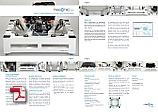
Resonic S 
Flexible guarantor for fast and accurate measurements
In essence, the Resonic measurement system consists only of a horizontal platform that carries the test object, several spring packages that softly suspend the platform, and a rigid support structure.
After the test object has been lifted onto the platform, the operator sets the platform in motion with a manual push, whereupon signals from the resulting free vibrations are picked up by the force sensors and sent to the Resonic software. After the predetermined measuring time expires, the software immediately computes the complete inertia properties and achieves high accuracy.
For measurement services, the Resonic 100S, Resonic 350S and Resonic 450S systems are used. The Resonic 100S covers test objects up to 100 kg, whereas the Resonic 350S and Resonic 450S are used for heavier test objects up to 350 and 450 kg, respectively.
Application areas include engine blocks, different vehicle components and motorbikes.
The horizontal platform is suspended on the rigid support structure by several spring packages. A spring package consists of a conventional tension spring, a low-friction spherical joint at each end, and, in some cases, a tension force sensor.
Because the spring rates are known, the force sensors are capable of measuring the platform motion. In order to cover all degrees of freedom, at least six sensors are necessary. A well-tried configuration consists of eight “measurement springs” with sensors and a variable number of “load-carrying springs” without sensors. Depending on the weight of the test object, the load-carrying springs can be added or removed in order to adjust the measurement range. In this way, an optimal configuration can be achieved, even for measuring the inertia of the empty platform.
Step 1 The test object is suspended on soft extension springs, either directly or via a platform component.
Step 2 The test object is given a random manual impulse. Signals of the resulting free vibrations are picked up by force sensors at some of the springs and sent to a PC through a USB-Interface.
Step 3 Based on the vibration signals, the Resonic software computes the complete inertia properties. The computational procedure is highly complex and represents the core of the Resonic innovation.

























